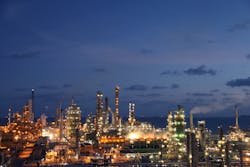Brazilian regulators approve Petrobras’s proposed RLAM refinery sale
The Brazilian government has approved Petróleo Brasileiro SA’s (Petrobras) proposed sale of its 333,000-b/d Refinaria Landulpho Alves (RLAM) refinery in São Francisco do Conde in the Recôncavo Baiano region of Bahia, Brazil, to Mubadala Capital (MC), an arm of Abu Dhabi-based Mubadala Investment Co. (OGJ Online, Feb. 9, 2021).
Brazil’s Administrative Council for Economic Defense (CADE) granted its approval for the planned sale of assets on June 9 as part a June 2019 agreement between Petrobras and CADE governing the operator’s ongoing program to divest most of its Brazilian refining and related logistics assets, as well as the opening of Brazil’s refining sector to increased competitiveness and transparency, Petrobras said.
The deal is subject to a 15-day waiting period required by law before the parties can finalize it as well as other customary closing conditions as outlined in a sales and purchase agreement with MC signed Mar. 24 (OGJ Online, Mar. 25, 2021).
As part of the deal, Petrobras agreed to sell its shares in the RLAM refinery and related assets—including four storage terminals and a set of pipelines totaling 669 km—to MC Brazil Downstream Participações for $1.65 billion, pending adjustments to the sale price due to variations in working capital, net debt, and investments that may arise between now and official closing of the transaction.
Petrobras—which will continue operating RLAM and its associated assets until the transaction closes—also agreed to offer ongoing support to Mubadala for a transitional period following the sale as part of a service agreement to ensure the safety and uninterrupted operation of the assets.
Petrobras previously confirmed its competitive sales process remains underway for the other seven refining assets involved in its downstream divestment program, including:
• The 208,000-b/d Refinaria Alberto Pasqualini (REFAP) refinery—with assets that include two storage terminals and a set of pipelines totaling 260 km—in Rio Grande do Sul.
• The 46,000-b/d Isaac Sabbá refinery (REMAN)—including a storage terminal—in Manaus, Amazonas.
• The 8,000-b/d Lubrificantes e Derivados de Petróleo do Nordeste (LUBNOR) refinery in Fortaleza, Ceará, which is one of the national leaders in asphalt production, as well as the only plant in Brazil to produce naphthenic lubricants.
• The 6,000-b/d Unidade de Industrialização do Xisto (SIX) unit—including a mine in one of the largest oil shale reserves in the world and a shale processing plant—in São Mateus do Sul, Paraná.
• The 166,000-b/d Refinaria Gabriel Passos (REGAP) refinery—including a set of pipelines of more than 720 km—in Betim, Minas Gerais.
• The 130,000-b/d Refinaria Abreu e Lima (RNEST) refinery—which has the potential to double its capacity 260,000 b/d with startup of a second processing line and includes both a terminal and a 101-km set of short pipelines—in Pernambuco.
As of January, Petrobras said it had received a binding proposal from and was in the negotiation phase with Ultrapar Participações SA for REFAP, with binding offers received and ongoing negotiations with unidentified parties also under way for REMAN, LUBNOR, and SIX.
Existing refining system
While the downstream divestment program remains ongoing, Petrobras said on May 24 it is proceeding with a program to prepare its remaining refining assets for an open, more competitive market in the country, as well as for the transition to a low-carbon economy.
Known as RefTOP, the program consists of a set of initiatives that seek to implement improvements to increase efficiency and operational performance of Brazilian refineries not involved in the divestment portfolio, which include its:
• 170,000-b/d Refinaria Presidente Bernardes (RPBC) refinery in Cubatão, São Paulo.
• 239,000-b/d Duque de Caxias (REDUC) refinery in the Baixada Fluminense area of Duque de Caxias, Rio de Janeiro.
• 57,000-b/d Refinaria de Capuava (RECAP) in Mauá, São Paulo.
• 434,000-b/d Refinaria de Paulínia (REPLAN) refinery in Paulínia, São Paulo.
• 252,000-b/d Refinaria Henrique Lage (REVAP) in São José dos Campos, São Paulo.
Alongside initiatives to increase the refineries' energy performance by enabling better reuse of inputs such as natural gas, electricity, and steam generated by Petrobras’s own operations, the RefTOP program also will promote the use of digital technologies, automation, and robotization throughout the refining complexes, including expanding existing use of digital twins.
Another important driver of the program is increasing production of high value-added products such as diesel and propylene, the latter of which will serve as feedstock for the petrochemical industry to help meet rising demand for plastics.
Petrobras said the program will help the refineries leverage processing of Brazil’s own low-sulfur presalt crudes, achieving competitive advantages and opportunities for increasing margins by favoring production of low-sulfur S-10 diesel and bunker fuel.
Petrobras said it plans to invest about $300 million in the RefTOP program through 2025, which is included as part of $3.7 billion in total investments as part of the operator’s 2021-25 strategic plan.
About the Author
Robert Brelsford
Downstream Editor
Robert Brelsford joined Oil & Gas Journal in October 2013 as downstream technology editor after 8 years as a crude oil price and news reporter on spot crude transactions at the US Gulf Coast, West Coast, Canadian, and Latin American markets. He holds a BA (2000) in English from Rice University and an MS (2003) in education and social policy from Northwestern University.

